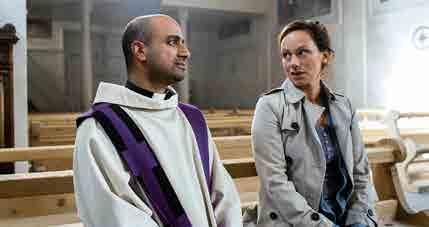
19 minute read
HEIMAT/DOMOWNJA/DOMIZNA HOMELAND/DOMOWNJA/DOMIZNA
HEIMAT DOMOWNJA DOMIZNA HEIMAT DOMOWNJA DOMIZNA HEIMAT DOMOWNJA DOMIZNA
Die Sektion begibt sich 2019 ins Lausitzer Braunkohlerevier und zu Menschen, die dort mit dem beständigen Wandel leben und versuchen, im Neuen das Alte zu bewahren.
Advertisement
Exemplarisch dafür steht „Der letzte Braschka im Revier. Helmut Kurjo“ – so der Titel des ihm gewidmeten Programms. In den Dörfern zwischen Schwarze Pumpe und Hoyerswerda hat er als Einziger seine sorbische Muttersprache bewahrt. Drei Filme aus vier Jahrzehnten dokumentieren zugleich das Verschwinden einer ganzen Kultur.
Ein Thema, dem sich auch der Cottbuser Schriftsteller Jurij Koch immer wieder gewidmet hat, unter anderem in seiner Novelle „Der Kirschbaum“. Anlässlich seiner Digitalisierung gelangt der nach ihr entstandene Film SEHNSUCHT nun wieder zur Aufführung.
Das zur Tradition gewordene sorbisch-sprachige Programm präsentiert verschiedene Portraits: der sorbisch-katholischen Antifaschistin Marja Grólmusec, des slowakischen Choreografen und Altmeisters des sorbischen Folkloretanzes Juraj Kubańka und von Menschen in der Lausitz, die aus unterschiedlichen Beweggründen die sorbische Sprache und Kultur heute am Leben halten – VERLIEREN UND FINDEN feiert Weltpremiere. Welche Spuren die Wenden und das Wendische in der Mark Brandenburg hinterlassen haben, erkundet Bernhard Sallmann im vierten Teil seines Fontane-Zyklus, den wir erstmals in voller Länge am Festival-Sonntag präsentieren.
Seine internationale Premiere feiert in Cottbus ein Schweizer Film, der sich mit dem Aufreger-Thema in unserer Region schlechthin beschäftigt und teilweise auch hier gedreht wurde: DIE RÜCKKEHR DER WÖLFE. Die Schweiz macht auch vor, wie eine „Minderheitensprache“ – um diesen diskriminierenden Begriff hier einmal zu gebrauchen – Mainstreamkino werden kann: Wir präsentieren die rätoromanische Komödie AMUR SENZA FIN.
GUNDERMANN REVIER schließlich bündelt globale Fragen, die sich in der Lausitz und im Werk ihres großen Sohnes brennpunktartig spiegeln: Heimat und Industrie, Utopie und Verlust. GL
Die vier Filme ODERLAND. FONTANE, RHINLAND. FONTANE, SPREELAND. FONTANE und HAVELLAND. FONTANE aus dem Fontane-Zyklus von Bernhard Sallmann werden vom DOK Leipzig – Internationales Leipziger Festival für Dokumentar- und Animationsfilm – präsentiert.
This year the Heimat/Domownja/Domizna programme section sets off on a journey to the brown coal fields of Lusatia and the people who, finding themselves in a constant state of flux, attempt to hold on to tradition despite the onset of a fundamentally new era.
This is perfectly exemplified by Helmut Kurjo, who is paid tribute to in the film series “The Region’s Last Braschka. Helmut Kurjo”. In villages from Schwarze Pumpe to Hoyerswerda he alone attempts to preserve his native language, Sorbian. Three films, produced over four decades, chronicle the disappearance of a culture.
These are issues that Cottbus-born author Jurij Koch repeatedly dedicated his creative energies towards, as was the case in the novel “Der Kirschbaum” (cherry tree). To mark the occasion of the latter‘s digitalisation its film adaptation LONGING again features.
The now traditional Sorbian-language programme presents a range of portraits: of the Sorbian Catholic anti-Fascist Marja Grólmusec, of Slovak choreographer and grand old master of Sorbian folk dance Juraj Kubańka and of various other individuals who continue to preserve the Sorbian language and culture: with regards to the latter, TO LOSE AND TO FIND celebrates its international premiere screening at this year‘s FFC. The traces left behind by the Wendish people and culture in the Mark Brandenburg are explored by Bernhard Sallmann in the fourth part of his Fontane cycle, every episode of which will be screened on the Sunday of the festival programme.
Due to celebrate its international premiere is a Swiss production which deals with an issue that also dominates the headlines in our region and was partly shot here: WOLVES RETURN. Switzerland also demonstrates how a “minority language”, to make use of what many regard as a discriminatory term, can become mainstream cinema: we feature the Rhaeto-Romanic comedy HIDE & SEEK.
Last but not least COAL COUNTRY SONG. GUNDERMANN unites questions of global significance that reverberate in Lusatia and in the works of its most famous son: homeland and industry, utopia and loss. GL Heimat/Domownja/Domizna wird unterstützt von der Stiftung für das sorbische Volk. Heimat/Domownja/Domizna is supported by the Foundation for the Sorbian People.
The four films ODERLAND. FONTANE, RHINLAND. FONTANE, SPREELAND. FONTANE and HAVELLAND. FONTANE from the Fontane cycle by Bernhard Sallmann are presented by DOK Leipzig – International Festival for Documentary and Animated Film.
AMUR SENZA FIN AMUR SENZA FIN HIDE & SEEK
Gieri kriegt bei seiner Frau keinen hoch, was an seiner Affäre mit Mona liegen könnte. Als Giulia dahinterkommt, verlässt sie ihn, eröffnet ein Café und flirtet mit dem attraktiven Michael. Göttlichen Frieden in die aufgebrachte Gemeinde soll der neue Pfarrer bringen, der indische Wurzeln hat. Der predigt statt der Bibel das Kamasutra … Flotte Mainstream-Komödie fast komplett auf Rätoromanisch. Eine Sprache, die nur von 40 000 Menschen gesprochen wird. Gieri can’t get it up with his wife, which could be due to his affair with Mona. When Giulia finds out, she leaves him, opens a café and flirts with handsome Michael. Heavenly peace is supposed to come to the scandalised community by way of the new pastor who is of Indian descent. Instead of the Bible he preaches the Kamasutra ... Lively mainstream comedy almost entirely in Rhaeto-Romance – a language that is spoken by only 40,000 people.
Christoph Schaub
Als Anfang 2018 das öffentlich-rechtliche Rundfunksystem in der Schweiz zur Disposition stand, entschlossen sich deren Macher zur Flucht nach vorn: Sie produzierten einen Spielfilm in einer „Minderheitensprache“. Man holte sich die besten Kräfte der Schweizer Filmindustrie, unter anderem den renommierten Regisseur Christoph Schaub und die Drehbuchautorin Sabine Pochhammer – beide keine Rätoromanen – ins Team. Es wurden Schauspielerinnen und Schauspieler gesucht, die aus dieser Kultur stammen, auch wenn ein Großteil von ihnen mittlerweile fast außerhalb des rätoromanischen Sprachraums arbeitet. AMUR SENZA FIN eröffnete 2018 das Internationale Filmfestival Locarno. Wenig später lief er – mit großer Resonanz – in der Primetime und mit deutschen Untertiteln im Schweizer Fernsehen. Auch international eine Erfolgsgeschichte: Der US-Weltvertrieb CMG, der für kommerziell funktionierendes Mainstream-Kino steht, kaufte die Rechte. Ein Fall mit Vorbildcharakter: Stellen Sie sich vor, es ist Sorbisch, und alle sähen hin! GL
When in early 2018 the public broadcasting system in Switzerland was up for renegotiation, its movers and shakers decided on a jump ahead: they produced a feature film in a ‘minority language’. They recruited the best talent in the Swiss film industry, including renown director Christoph Schaub and screenwriter Sabine Pochhammer, neither of them Rhaetians. Actors with this cultural background were cast, even though by now most of them mainly work outside the Rhaeto-Romance language region. In 2018, HIDE & SEEK opened the Locarno International Film Festival. A little later it was shown on prime-time Swiss television with German subtitles and received a great response. It proved a success also internationally: the US company CMG, a world distributor with a name for commercially successful mainstream cinema, bought the rights. An exemplary case: imagine it was Sorbian and everybody was watching! GL
Filmformat / Format DCP | Farbe / Colour Drehbuch / Script Sabine Pochhammer Kamera / Photography Pierre Mennel Ton / Sound Christoph Ulbich Schnitt / Editing Gion-Reto Kilias Musik / Music Balz Bachmann Ausstattung / Set Design Peter Scherz Darsteller / Cast Rebecca Indermaur, Bruno Cathomas, Tonia Maria Zindel, Murali Perumal, Marietta Jemmi Produzent / Producer Lukas Hobi Produktion / Production Cinema Management Group Co-Produktion / Co-Production Zeitgiest Films Kontakt / Contact Cinema Management Group Tiffany Kilgore marketing@cinemamanagementgroup.com 8383 Wilshire Blvd - Suite 320 Beverly Hills, CA 90211 Tel: + 1.310.300.9959 Fax: + 1.310.861.1159
DIE RÜCKKEHR DER WÖLFE DIE RÜCKKEHR DER WÖLFE WOLVES RETURN
„Wofür brauchen wir den Wolf?“, fragen zwei um ihre Tiere besorgte Schafhalter, und eine Wildtierbiologin antwortet: „Der kommt, der fragt uns nicht“. Was es tatsächlich heißt, mit dem Wolf zu leben, erkundet Thomas Horat in der Schweiz, Österreich, Bulgarien, Polen, Minnesota und der Niederlausitz, einem der Hauptdrehorte. Für und Wider, historische Exkurse, Emotionen, Informationen und spektakuläre Aufnahmen von einem Tier, das uns und unser Verhältnis zur Natur spiegelt. “What do we need the wolf for?”, two sheep farmers ask, worried for their livestock, and a wild animal biologist answers: “It comes, it doesn’t ask us.” Thomas Horat explores what it really means to live with the wolf in Switzerland, Austria, Bulgaria, Poland, Minnesota and Lower Lusatia, one of the film’s main locations. Pros and cons, historical digressions, emotions, information and spectacular footage of an animal that reflects us and our relationship with nature.
Thomas Horat
Ein Schafhalter in den Alpen, der sich aufgrund der kleinen Herdengröße einen Hütehund kaum leisten kann. Ein Verhaltensforscher, der im Wolf eine soziale Schwester des Menschen sieht. Ein Lausitzer Wolfsmanager, der Kindern spielerisch die durch Medien geschürte Angst vor dem Tier nimmt. Ein Ehepaar in der eisigen Einsamkeit der amerikanischen Wildnis, das die Präsenz der Wölfe täglich spürt. Ein Schafhirte in Bulgarien, der wie seine Vorfahren mit ihnen koexistiert. Ein Wissenschaftler, der erforscht, woher unsere Angst vor den Wölfen kommt und einer, der Regulierung fordert. Im Gegensatz zu der oft hitzig geführten öffentlichen Diskussion nähert sich Horat dem polarisierenden Thema fast kontemplativ, lässt die Menschen vor der Kamera ausreden und den Blick schweifen. Derart unaufgeregt befreit er Tier, Mensch und Debatte von ideologischem Ballast. Vor allem zeigt er die Schönheit einer Kreatur ganz ohne jegliche, heute gängige High-Tech-Effekte – so wie jeder sie entdecken könnte. GL

A sheep farmer in the Alps who can’t really afford a sheep dog due to the small size of his herd. A behavioural scientist who sees the wolf as mankind’s social sister. A Lusatian wolf manager who playfully stills children’s fear of the animal, stoked by the media. A couple in the icy solitude of the American wilderness who daily feel the wolves’ presence. A shepherd in Bulgaria who coexists with them like his ancestors. A scientist who researches where our fear of wolves stems from and another who demands regulation. In contrast to the frequently heated public debate, Horat approaches the polarising topic in an almost contemplative manner, hears the people in front of the camera out and lets his eye wander. In this calm way he liberates the animals, humans and the debate from ideological ballast. In particular, he showcases the beauty of a creature without any high-tech effects, so ubiquitous these days, just like anybody could discover it. GL
Filmformat / Format DCP | doc. | Farbe / Colour Drehbuch / Script Thomas Horat Kamera / Photography Luzius Wespe Ton / Sound Thomas Horat Schnitt / Editing Guido Henseler Musik / Music Artra Trio Darsteller / Cast Ueli Metz, Lieni Schneller, David Gerke, Reinhard Schnidrig, Gudrun Pflüger, Kurt Kotrschal, Michaela Walchhofer, Franz Holleis, Karsten Nitsch, Stephan Kaasche, Sabina Nowak, Robert Mysłajek, Natalia Niedźwiecka, Maciek Szewczyk, Elena Tsingarska, Ivan Beliov, L. David Mech, Shannon Barber-Meyer, Polly Carlson-Voiles, Steve Voiles, Johnnie Hyde, Bert Hyde Produzent / Producer Salome Pitchen Produktion / Production Settebello Film GmbH Co-Produktion / Co-Production SRF Schweizer Fernsehen Kontakt / Contact mythenfilm Thomas Horat thomas@mythenfilm.ch Tel: +41418200272 Mobile: +41775381268 Rickenbachstrasse 60 6430 Schwyz Schweiz
GUNDERMANN REVIER GUNDERMANN REVIER COAL-COUNTRY SONG. GUNDERMANN
GRIT LEMKE / DEUTSCHLAND / GERMANY, 2019, 98 MIN
Vielschichtiges und kenntnisreiches Porträt über den Liedermacher Gerhard Gundermann und lebendige Erinnerung an ein wichtiges Stück Zeitgeschichte, an den DDR-Alltag, den Mauerfall und die Zeit danach im Lausitzer Braunkohlerevier. Authentisch wie die Lieder von Gundermann, die den Dokumentarfilm als Soundtrack begleiten. Many-faceted and knowledgeable portrait of the songwriter Gerhard Gundermann and vivid reminiscence of an important time in contemporary history, everyday life in the GDR, the fall of the Berlin Wall and the subsequent time in the Lusatian lignite mining district. Authentic like Gundermann’s songs that provide the soundtrack for this documentary.
Grit Lemke
„Das Revier hat uns beede ausgespuckt, du hast es einmal umgegraben, aber wir wollten mehr bewegen.“ So beginnt Regisseurin Grit Lemke ihre kluge und sensible Annäherung an den Liedermacher Gerhard Gundermann und die Menschen seiner Generation in der Tagebau-Gegend in der Lausitz. Hier, in diesen „Löchern mit Dörfern dazwischen“, sind sie aufgewachsen. Einstellungen, die die monströse Schönheit der Abraumhalden und schweren Tagebautechnik zeigen, wechseln sich ab mit Archivaufnahmen, Fernsehinterviews, SchwarzWeiß-Fotos und den lebendigen Erinnerungen von Gundis Weggefährten. In der DDR diskutierten sie sich die Köpfe heiß, wollten den Staat verändern, in der „Wendezeit“ träumten sie vom großen Aufbruch. Dann kam die Wiedervereinigung, gefühlter Identitätsverlust, Arbeitslosigkeit für die einen, neue Chancen, der musikalische Durchbruch für andere. Und im Zentrum von allem: Gundermann. Der mehr Energie hatte, streitbarer und konsequenter war und immer bereit, mehr zu wagen als alle anderen. CF
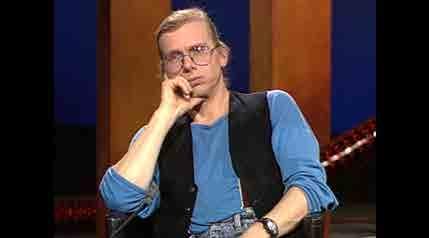
“The coalfield spat us both out, you once dug it over, but we wanted to stir things up more.” This is how director Grit Lemke begins her intelligent and sensitive approach to the songwriter Gerhard Gundermann and the people of his generation in the open pit-mining district in Lusatia. Here they grew up, in these “holes with villages in between”. Frames that portray the monstrous beauty of the waste dumps and heavy open-pit mining machinery alternate with archive images, television interviews, black-and-white photographs and the vivid recollections of Gundi’s companions. During the GDR era they engaged in endless discussions, wanted to change the state; during the time of the ‘Wende’ they dreamt of a great awakening. Then came the reunification, the perceived loss of identity, unemployment for some, new opportunities and a musical breakthrough for others. And at the centre of it all: Gundermann. Who had more energy, was more belligerent and consequent and was always prepared to risk more than anybody else. CF
Filmformat / Format DCP | doc. | Farbe / Colour Drehbuch / Script Grit Lemke Kamera / Photography Uwe Mann Ton / Sound Oliver Prasnikar Schnitt / Editing Sven Kulik Musik / Music Gerhard Gundermann Produzent / Producer Gregor Streiber Produktion / Production inselfilm produktion Kontakt / Contact inselfilm produktion Straße der Pariser Kommune 31 10243 Berlin www.inselfilm.info gregor@inselfilm.info +493077008849 +491792171998
JURAJ KUBAŃKA – MIŁOSĆ KAMJENJA JURAJ KUBAŃKA – DIE ZÄRTLICHKEIT DES STEINS JURAJ KUBAŃKA – THE TENDERNESS OF STONE
REINER NAGEL, HELLMUTH HENNEBERG / DEUTSCHLAND / GERMANY, 2019, 30 MIN
Die „Ballade vom Stein“ gilt als wichtigstes Werk, das der slowakische Choreograf Juraj Kubańka für das Sorbische Nationalensemble schuf. Der „Archäologe der sorbischen Folklore“ in Gesprächen, Erinnerungen von Weggefährten, Tanzszenen und Archivaufnahmen. The “Ballade vom Stein” (ballad of the stone) is regarded as the most significant work that Slovak choreographer Juraj Kubańka created for the Sorbian National Ensemble. Here we see the “archaeologist of Sorbian folklore” in discussions, reminiscences of companions, dance scenes and archive footage.
Reiner Nagel, Hellmuth Henneberg Filme ŁUŽYCA - UNTERWEGS IN TRANSKARPATIEN (2018, short, doc, FFC 2018) Heimat/Domownja/Domizna
In der schweren Arbeit in Lausitzer Steinbrüchen und vor allem im Granit selbst – der für ihn weiblich ist – entdeckte Kubańka eine Poesie, die er in teils kraftvolle, teils filigrane Tanzbewegungen übersetzte. Diesem schöpferischen Prozess folgt der Film vom Steinbruch über den Probenraum und durch Archive bis auf die große Bühne. Folklore ist für Kubańka die Wurzel jeder Kultur – ein Ansatz, der Beachtung und ein „sława“, die höchste sorbische Ehrerbietung, verdient. GL
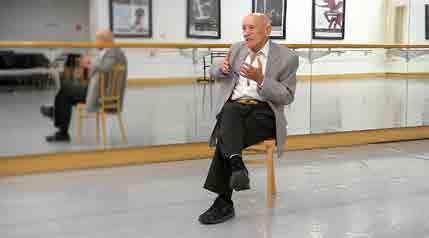
In the arduous labour of the Lusatian stone quarries and, no less, in the granite itself (which he regards as feminine), Kubańka discovered a poetry which he transformed into dance movements that are at once both delicate and powerful. This work traces the process from its origins in the stone pits via the rehearsal room and archives to the stage. For Kubańka folklore is the root of every culture, an approach deserving of both consideration and a “sława”, the highest form of deference the Sorbian culture has to offer. GL
Filmformat / Format DCP | DOC | Farbe / Colour Kamera / Photography Reiner J. Nagel Ton / Sound Ralf Henkel, Mirko Franceschina Schnitt / Editing Antje Höpfner Produzent / Producer Ulrich Kohrt, Mirko Franceschina Kontakt / Contact hellmuth.henneberg@rbb-online.de peggy.krueger@rbb-online.de
LISTY. BRIEFE – IN GEDENKEN AN DR. MARIA GROLLMUSS BRIEFE – IN GEDENKEN AN DR. MARIA GROLLMUSS LETTERS – IN MEMORY OF DR MARIA GROLLMUSS
TONI BRUK / DDR / GDR, 1985, 19 MIN
Sorbin, Katholikin, Publizistin, Antifaschistin, Kommunistin – vor 75 Jahren, am 6. August 1944, starb Marja Grólmusec (Maria Grollmuß) im KZ Ravensbrück. Fragmente von Erinnerungen an eine Biografie, wie es sie in der Lausitz auch gab. A Sorb, Catholic, publicist, anti-Fascist and Communist: 75 years ago, on August 6th 1944, Marja Grólmusec (Maria Grollmuss) died at Ravensbrück concentration camp. The film features fragmented reminiscences of an individual and her fate, the likes of which also occurred in Lusatia.
Toni Bruk Filme VOM MALER MIT DEM LINDENBLATT (1986, short, doc, FFC 2017) SOKOŁ - P.S. ZU EINEM KAPITEL UNSERER GESCHICHTE (1989, doc, FFC 2017) UND AUF STEHT DIE WAHRHEIT; GAŽ WĚTŠYK DUJO (1984, short, doc, FFC 2018) Heimat/Domownja/Domizna
Aus Briefen an ihre Schwester, Dokumenten, Fotos, Erzählungen von Kindern der Maria-Grollmuß-Schule ihres Heimatdorfes Radibor und Erinnerungen von Weggefährtinnen und -gefährten entsteht das Bild einer hochsensiblen Intellektuellen, die aufrecht den sicheren Tod in Kauf nahm. Elegische Naturaufnahmen und Orgelmusik schaffen dabei einen beständigen Bezug zu einer tiefen Spiritualität und Religiosität, aus der sich sowohl die kommunistische Weltanschauung als auch die Widerstandskraft von Grólmusec speisten. GL From her correspondence with her sister, documents, photos, tales from children who attend her home-town Radibor‘s Maria-Grollmuss School and reminiscences of one-time companions a portrait emerges of a highly-sensitive individual who met her fate of a certain death with dignity. All the while elegiac landscape footage and organ music ensure a constant presence of a deeper religiousness and spirituality which in turn energised both Grólmusec‘s Communist world-view as well as her will to resist. GL
Filmformat / Format 35mm| doc. | Farbe / Colour Drehbuch / Script Toni Bruk Kamera / Photography Michael Börner Musik / Music Thomas Sauer Produktion / Production DEFA-Studio für Trickfilme Kontakt / Contact Deutsche Kinemathek - Museum für Film und Fernsehen DEFA-Filmverleih Mirko Wiermann Potsdamer Str. 2 10785 Berlin Germany +49 30 30 09 03 63 4 www.deutsche-kinemathek.de defa-filmverleih@deutsche-kinemathek.de
PUŠĆIŚ A PŚIMJEŚ VERLIEREN UND FINDEN TO LOSE AND TO FIND
Verloren glauben viele das Sorbische in der Niederlausitz. Aber es gibt Menschen, die darin etwas finden – Verbindungen zur eigenen Geschichte, Familie, Berufung oder einfach: Heimat. Premiere der neuen Łužyca-Produktion. Many believe Lusatia‘s Sorbian heritage to be long lost and yet there are individuals who continue to find something: be that connections to their history, family, a calling or simply: home. The premiere screening of a newly-released Łužyca production.
Roman Pernack
Filme EINE GESTE, EIN HAUCH, EIN KOSMOS - DER KOMPONIST JURO MĚTŠK (2018, short, doc, FFC 2018)
Ein Kahnfährmann im Spreewald, der seine sorbischen Wurzeln achtet, aber die Sprache nicht spricht. Eine Lehrerin, die mit ihr nicht aufwuchs, aber sie heute engagiert verbreitet. Ein rasender Reporter, der sie an seine Kinder weitergibt, sich damit aber von der sorbischen Community oft allein gelassen fühlt. Ein Linguist, den sein Interesse für „Minderheitensprachen“ in die Lausitz geführt hat … Alltagsbeobachtungen und die Frage: Was macht es aus, das Sorbische? Sprache oder Herkunft? GL
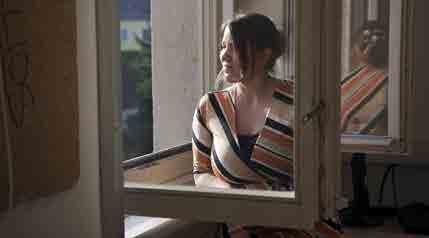
The Sorbian language: a boatman in the Spreewald who takes care to cultivate his Sorbian roots and yet can‘t speak it. A teacher who, though she wasn‘t exposed to it as a child, today makes every effort to promote its dissemination. A frantic reporter who, in passing it on to his children, sometimes feels isolated within the wider community. And a linguist whose interest in “minority languages” takes him to Lusatia. Everyday observations and the question: what is it that makes one Sorbian? Family and local background or language? GL
Filmformat / Format DCP | DOC | Farbe / Colour Drehbuch / Script Roman Pernack Kamera / Photography Roman Pernack Ton / Sound Christian Heinbockel, Ralf Henkel, Mirko Francheschina Schnitt / Editing Rudi Zieglmeier Produzent / Producer Ulrich Kohrt, Mirko Francheschina Produktion / Production rbb
SEHNSUCHT SEHNSUCHT LONGING
JÜRGEN BRAUER / DDR / GDR, 1989, 95 MIN
In einer Regennacht klingelt ein Fremder an der Tür eines abgelegenen Hofes in der Lausitz. Ena, mit dem Bauern Mathias verlobt, wird sich in ihn verlieben, mit ihm fortgehen und schmerzhaft herausfinden, wo sie hingehört. Die mystische, von Traditionen durchzogene Welt des sorbischen Dorfes kollidiert mit der rationalen des Ingenieurs, der Seen entstehen lässt. On a rainy night, a stranger knocks on the door of a remote farm in Lusatia. Ena, engaged to farmer Mathias, will fall in love with this stranger, leave with him and painfully discover where she belongs. The mystic world of the Sorbian village, steeped in tradition, collides with the rational attitude of the engineer who creates lakes.
Jürgen Brauer
Filme GRITTA VON RATTENZUHAUSEBEIUNS (1984, FFC 2012) TANZ AUF DER KIPPE (1990, FFC 2017)
Vorlage bildet die 1984 erschienene Novelle „Der Kirschbaum“ von Jurij Koch, die von den Lesern geliebt, von der Kritik gefeiert, in mehrere Sprachen übersetzt und von ihm als seine „wohl gelungenste Arbeit“ bezeichnet wurde. Schon 1981 entstand die Filmidee, konnte jedoch erst 1989 von Jürgen Brauer realisiert werden. Als SEHNSUCHT im Mai 1990 uraufgeführt wurde, ging seine Brisanz in der Aufregung der „Wendezeit“ unter. Fast drei Jahrzehnte später ist die Infragestellung eines blinden Fortschrittsglaubens aktueller denn je. Der Film überzeugt darüber hinaus nicht nur durch die lyrische Verdichtung und das intensive Spiel von Ulrike Krumbiegel und Ulrich Mühe in den Hauptrollen, sondern ist auch filmhistorisch eine Rarität. Kaum einmal wurde und wird im deutschen Film sorbische Lebenswelt, zumindest was die Festkultur betrifft und nicht zuletzt durch die Mitwirkung „echter“ Dorfbewohnerinnen, so beiläufig und kraftvoll dargestellt. Die Aufführung erfolgt aus Anlass der Digitalisierung des Werks durch die DEFA-Stiftung, das somit der Nachwelt erhalten bleibt. GL
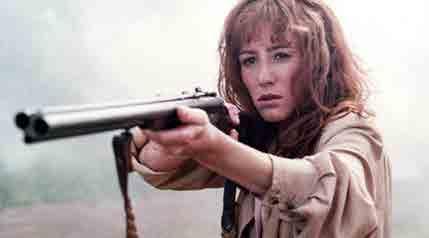
The source material is Jurij Koch’s novella “Der Kirschbaum” (“The Cherry Tree”), which is much loved by readers, was translated into several other languages and which he himself considers his “perhaps best-made work”. The idea to turn it into a film originated as early as in 1981, but it was not until 1989 that Jürgen Brauer could bring it about. When LONGING was first screened in May 1990, its explosive nature went under in the excitement of the ‘Wende’ period. Almost three decades later, the questioning of a blind belief in progress is more topical than ever. The film moreover satisfies not only with its lyrical compaction and the intensity of Ulrike Krumbiegel and Ulrich Mühe in the lead roles but is also a rarity in terms of film history. Sorbian life has hardly ever been depicted as casually and powerfully in German film as here, at least with regards to its culture of festivities and in no small measure due to the involvement of ‘real’ villagers. The film is screened on occasion of its digitisation by the DEFA Foundation, thus being made fit for posterity. GL
Filmformat / Format DCP | Farbe / Colour Drehbuch / Script Jürgen Brauer Kamera / Photography Jürgen Brauer Schnitt / Editing Erika Lehmphul Musik / Music Ralf Hoyer Ausstattung / Set Design Georg Wratsch Darsteller / Cast Ulrike Krumbiegel, Ulrich Mühe, Thomas Büchel, Martin Trettau, Kahtarina Lind, Benno Mieth, Thomas Bading, Dieter Rutnowski, Wolfgang Kotissek, Günter Wolfram Produzent / Producer DEFA Studio Kontakt / Contact Deutsche Kinemathek - Museum für Film und Fernsehen DEFA-Filmverleih Mirko Wiermann Potsdamer Str. 2 10785 Berlin Germany +49 30 30 09 03 63 4 www.deutsche-kinemathek.de defa-filmverleih@deutsche-kinemathek.de








